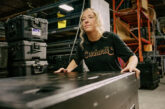
James Whitaker, Marketing Director at Dickies, explores the evolution of modern workwear.
As a company first established in 1922, we’ve witnessed the progression of workwear over the past 96 years.
As tradespeople rely on workwear to support them in all kinds of environments, functionality, durability and affordability naturally remain top priorities. However, there’s been a real rise in demand for workwear that helps them to cultivate a professional – and even fashionable – image.
As workwear manufacturers, the biggest challenge for us is to create functional, practical clothing – that also meets modern health and safety standards – with a stylish approach to design.
A modern image
Today’s electricians care about what their clients think and want outfits that can see them from job, to meeting a potential client, to the pub – or that simply don’t look out of place when walking down the high street.
To meet this demand, we’ve launched the Dickies Pro range, which offers smart and durable workwear that doesn’t compromise on comfort and practicality. Available in five colour-ways, the smart two-tone collection includes trousers, jackets, T-shirts, caps and belts and can be worn as separates or as a coordinated outfit for a more professional finish.
Designed using flexible materials such as Stretch Tencate – plus Coolcore to regulate moisture and Cordura to offer extra defence against wear and tear on elbow panels and knees – the range also incorporates UV protection (UPF 45+) and is made from hypoallergenic fabric.
As with all our ranges, every item of Dickies Pro clothing has been designed and thoroughly tested to help make working life more productive – and, of course, safe.
A close eye on safety
Safety factors do, in fact, have a major influence on our designs, with the health and safety regulations that govern the industry naturally filtering through to workwear.
This means we have to review essential health and safety requirements that have been laid down by the EU Parliament. UK and EU politics aside, these requirements outline, among others, design principles and ergonomic stipulations.
As an example, the requirements for hi-visibility clothing, detailed in the standard EN ISO 20471, dictate a number of factors that must be taken into account when designing workwear – such as ensuring the wearer is visible from any angle.
To ensure we fully adhere to all regulations placed on us as a manufacturer – and that our products meet our exacting standards of quality – we set up the Dickies Europe Quality Assurance Department and Laboratories, which closely monitors and measures product performance. Accredited third party certification houses offer additional support by independently assessing products against industry standards.
Looking to the future
In order to stay competitive, manufacturers are increasingly focused on creating workwear that gives tradespeople the flexibility and choice to wear outfits that reflect the image they want to create while on the job. Plus, with workwear producers harnessing the latest technology available throughout the design process, the quality of what’s on offer is better than ever.
There’s no need for tradespeople to compromise when it comes to workwear – functional, practical designs that make their jobs as easy and as safe as possible, while cultivating a professional style, is something they should demand whenever shopping for new clothing and footwear.
For more information about the range of workwear available from Dickies visit: www.dickiesworkwear.com








